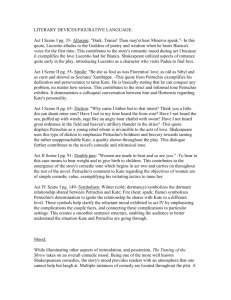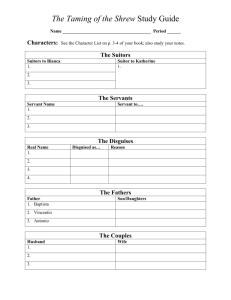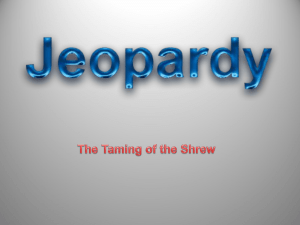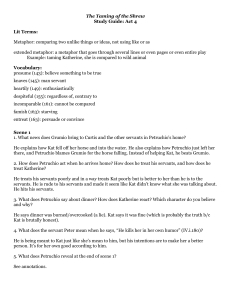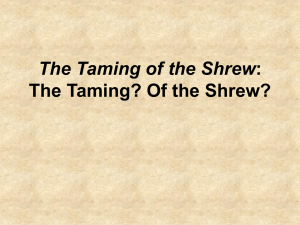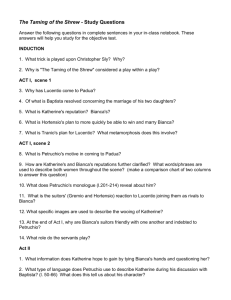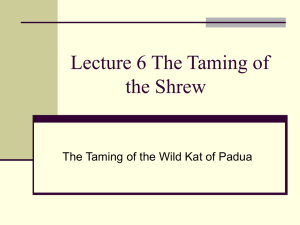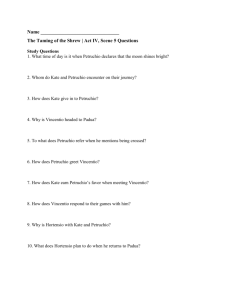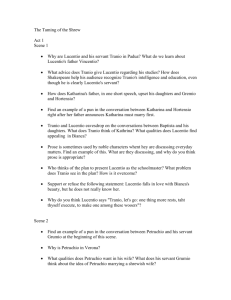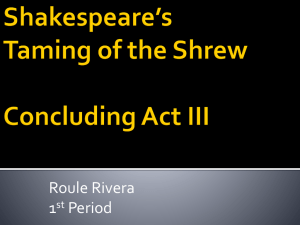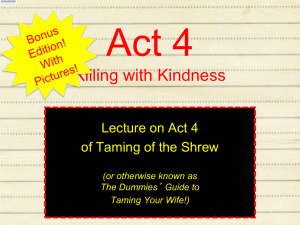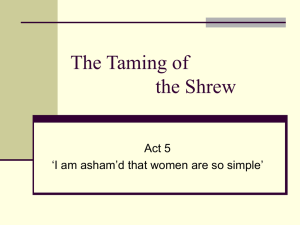Lecture 4 The Taming of the Shrew
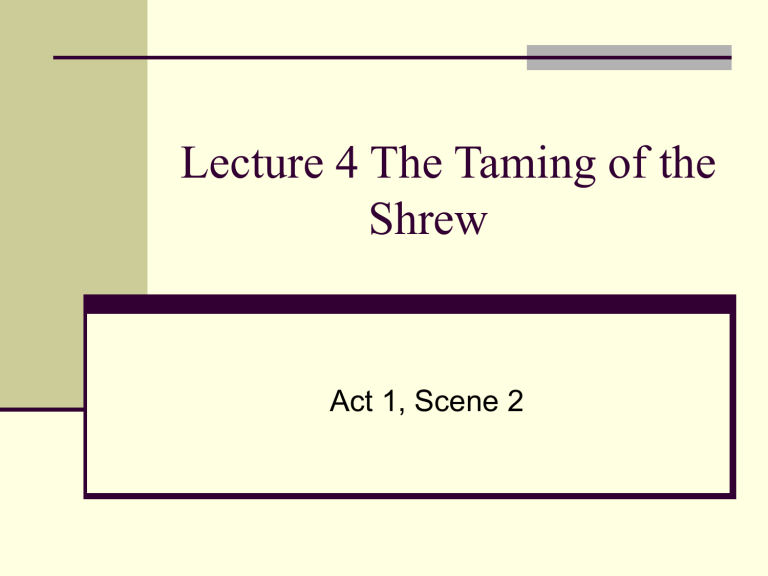
Lecture 4 The Taming of the
Shrew
Act 1, Scene 2
Lecture Focus
Sources of Conflict in Drama, Women in Literature, and Shrew
Additional background critical considerations in relation to Act 1, and Plot
Highlights of Act 1, Scene 2,
Dramatic presentation of character
The threefold Structure: Induction; Main Plot; and
Sub-Plot
Dramatic Techniques
Dramatic Effects
Theme of Appearance and Reality
Think of sources of Conflict?
Money; property;
Women, especially young, beautiful women;
Love; eros; romance; sexual desire;
Other men; especially men of wealth, power, and influence; ambition; competition
Masculine Power, and power disputes;
Male-Female rivalry; The battle of the sexes; and how women contest male power, domination and control [Paper 5 Concerns]
Conflict arising from ourselves; inner conflict
Conflict between Appearance and Reality; Disguise
Women in Literature / Drama
How female experience is portrayed in
Literature? Dramatized in Drama?
How is female experience portrayed in
Shakespeare? More particularly in Shrew ?
Was Shakespeare a chauvinist? Sexist?
Shakespeare put language into the mouths of many of his male characters that nowadays appears sexist, given its uncomplimentary references to women;
Consider Petruchio’s ‘chattel’ speech
Petruchio speaks of his wife, Kate:
‘She is my goods, my chattels; she is my house,
My house-hold stuff, my field, my barn,
My horse, my ox, my ass, my anything.’ [Act 3, Sc 2]
Students need to balance such evidence against
Shakespeare’s portrayal of his female characters;
Explore different ways of speaking Petruchio’s lines;
Critically consider how serious is he? Or is it all intended not to be taken seriously? As a joke?
Is this one of Petruchio’s disguises?
What of other women characters in Shakespeare?
Shakespeare’s plays are filled with resourceful, self-confident women
Who create their own space, and achieve or represent a spirited independence;
Lady Macbeth, Gonerill and Regan;
Cleopatra; Beatrice; and Katherina
Some feminist literary critics interpret his plays as sympathetic to feminism;
Others see Shakespeare as supportive of patriarchy. (Through reasoned argument)
Patriarchy, Eros and Sexuality
Just as sexuality has always been constituted within the parameters of a male bodily order
So the feminine and eros have been constituted within a masculine economy of pleasure and power;
A culture where men govern the nature of all erotic, amorous, and sexual experience;
Consider these perspectives in relation to your Paper 5 concerns in your set texts.
Many of Shakespeare’s plays concern themselves with the nature of women, their position / place in society and their treatment;
In The Taming of the Shrew , Katherina has to be ‘taught’ obedience before she can be deemed suitable to become a wife in marriage.
Marriage is seen as the foundation of a happy and orderly life.
Bianca Katherina
Gentle
Good
Sweet
Obedient
Respectful
Silent; mild
‘Beauteous modesty’
Rough
Impatient
Disobedient
Bad-tempered
Rebellious
Violent
‘Scolding tongue’
Recalling Kate’s first speech [Sc 1]
It is vulgar, and thick-sown with proverbs;
She threatens to ‘comb’ her suitor’s ‘noddles’ with a three-legged stool;
It is all very scolding and violent
And appropriately expressed in a low style
(as opposed to a high style )
Her choice and form of more vulgar language reinforces this shrewish impression of her character
Exposition (Delay and Integration)
The title creates an expectation of conflict between a man and his wife
Induction presents us immediately with a dispute between the Hostess and a Beggar (Tinker)
Followed by a long episode in which a Lord and his train plan to deceive the sleeping Beggar that he too is a lord;
This is interrupted by the arrival of the actors, after which the Lord’s plot is seen in operation,
With Sly deceived for over a hundred lines until the actors come to perform their comedy;
The play-within-the-play then begins with the sub-plot —
with Lucentio, along with his servant Tranio, arriving in Padua to pursue a course of study
and then meeting Baptista, his daughters and their suitors;
Up to this point in the play there has been no hint of a shrew
Main Plot and Sub-Plot
At Act 1, Scene 1, 48
The main plot and sub-plot are linked by
Baptista’s initial announcement:
‘Gentlemen, importune me no further,
For how I firmly am resolv’d you know;
That is, not to bestow my youngest daughter
Before I have a husband for the elder.’
It is from this decision of Baptista that all the intrigue of the sub-plot flows with Hortensio, Lucentio and
Gremio, pursuing their various schemes to win over
Bianca;
The contest for Bianca is also a parallel to and a reversal of the contest between Petruchio and
Katherina;
In both plots, courtship is seen as a struggle, a conflict
Shakespeare signals this by the way in which after
Act 1, Scene 1, the plots interweave.
The two plots are reversals of each other.
Moving on to Scene 2 of Act 1
Petruchio comes to Padua in search of a rich wife;
He is introduced in a low comedy style with his servant, Grumio
With great flourish, he proclaims his intention to marry for money; (Marriage as a market)
He agrees to court Katherina
Action initially takes place outside Hortensio’s house
Lazzi, and Dramatic, Comic Effects
Petruchio is introduced in a low comedy turn with his servant Grumio
Commedia depended for most of its comic effects on gags known as lazzi , largely surplus to the actual plot
In this scene, there is the classic ‘Knock me here’ gag, which depends on Grumio not understanding a clear instruction he must realistically have heard many times before
The upshot of this failure of understanding on
Grumio’s part
The stage direction directing Petruchio:
< He wrings him by the ears >
Once again the servant is abused
Does this action have thematic relevance?
It signals to the audience Petruchio’s potential for physical violence;
NOTE: Actors and directors have to choose how comically these scenes are performed
Plot Contrast in Characterization
Lucentio’s rapturous passion in Act 1, Scene
1 is contrasted not only with Petruchio’s realistic and pragmatic declaration
‘I come to wive it wealthily in Padua’
Watch out for these contrasts re- both plots;
As they comment ironically on each other;
Critically explore direct comparisons and contrasts between Petruchio and Lucentio as the principal wooers
Petruchio is superficially direct, simple, overbearing, and businesslike;
Do you agree?
Lucentio is lovesick, yet devious; Yes or No?
Why say he is devious?
Any supporting textual evidence?
Recall he employs Tranio to adopt a disguise in order to do all his real work for him
Petruchio [lines 62-73] Effects?
[Signor Hortensio, ’twixt such friends as we
Few words suffice, and therefore, if thou know
One rich enough to be Petruchio’s wife—
As wealth is burden of my wooing dance —
Be she as foul as was Florentius’ love,
As old as Sibyl, and as curst and shrewd
As Socrates’ Xanthippe or a worse,
She moves me not, or not removes at least
Affection’s edge in me, were she as rough
As are the swelling Adriatic seas .]
[I come to wive it wealthily in Padua;
If wealthily, then happily in Padua.]
Dramatic Techniques?
Modulation of stress patterning to produce particular effects;
Altering line length, and inserting pauses;
Interplay between lines, and sentences
Enjambment, and End-stopping
Rhetorical figures of speech (techniques of persuasive language);
E.g. Anaphora and Hyperbole
Metaphorical techniques; Imagery
Effects? Show how they are achieved?
Conveys a sense that he an invincible, unstoppable force; nothing stands in his way; No nonsense;
A man to be reckoned with; we are impressed
A typical audience will react with amused admiration for his egotistic, bravado, macho spirit and energy;
Comic effects arise from the inflated and exaggerated rhetoric; (very masculine, muscular discourse)
It will arouse suspense as the audience awaits in eager anticipation of an encounter between the so called Shrew of Padua, and this newcomer, Petruchio
For further dramatic effects
Compare and contrast characterization and events in the sub-plot with that of main plot
Contrast Petruchio’s speech with Lucentio earlier on in Scene 1 of Act 1 —
‘I burn, I pine, I perish…/ Counsel me , Tranio
/ Assist me , Tranio…’
Note the dependence on his servant!
Effects arising from the Induction
In the Induction, there are portrayals of a Lord and his huntsmen; First Huntsman and
Second Huntsman, and references to aspects and elements of hunting,
‘Dost thou love hawking? / Or wilt thou hunt? /
Say thou will course, thy greyhounds…’
There is a sense in Petruchio’s speech of the metaphor of the hunt; of hunting;
Petruchio as a fortune-hunter
Towards end of Act 1, Scene 2
By the end of this scene Petruchio is already thinking and talking about Katherina as if she were his possession already:
‘Sir, sir, the first is for me ; let her go by.’
Effect? (dramatic / theatrical)
We can see how determined and decisive he is in his pursuit; in his fortune-hunting!
Conflict: Appearances and Reality
The Induction compels us to question the boundaries between appearance and reality; So what’s real?
Thus warning the audience of the ambiguity of belief;
And in doing so, it foreshadows the use of disguises and performances in the sub-plot, and main plot;
Creating much dramatic irony in the play;
But does Petruchio disguise himself?
Is he not more upfront, more direct about his motives and intentions, even with Kate?
But then is not Petruchio an actor? Does he not set out to act and play different parts, adopting different personas? Is he not putting on a false front?
So how is Kate to gauge him? And the audience?
